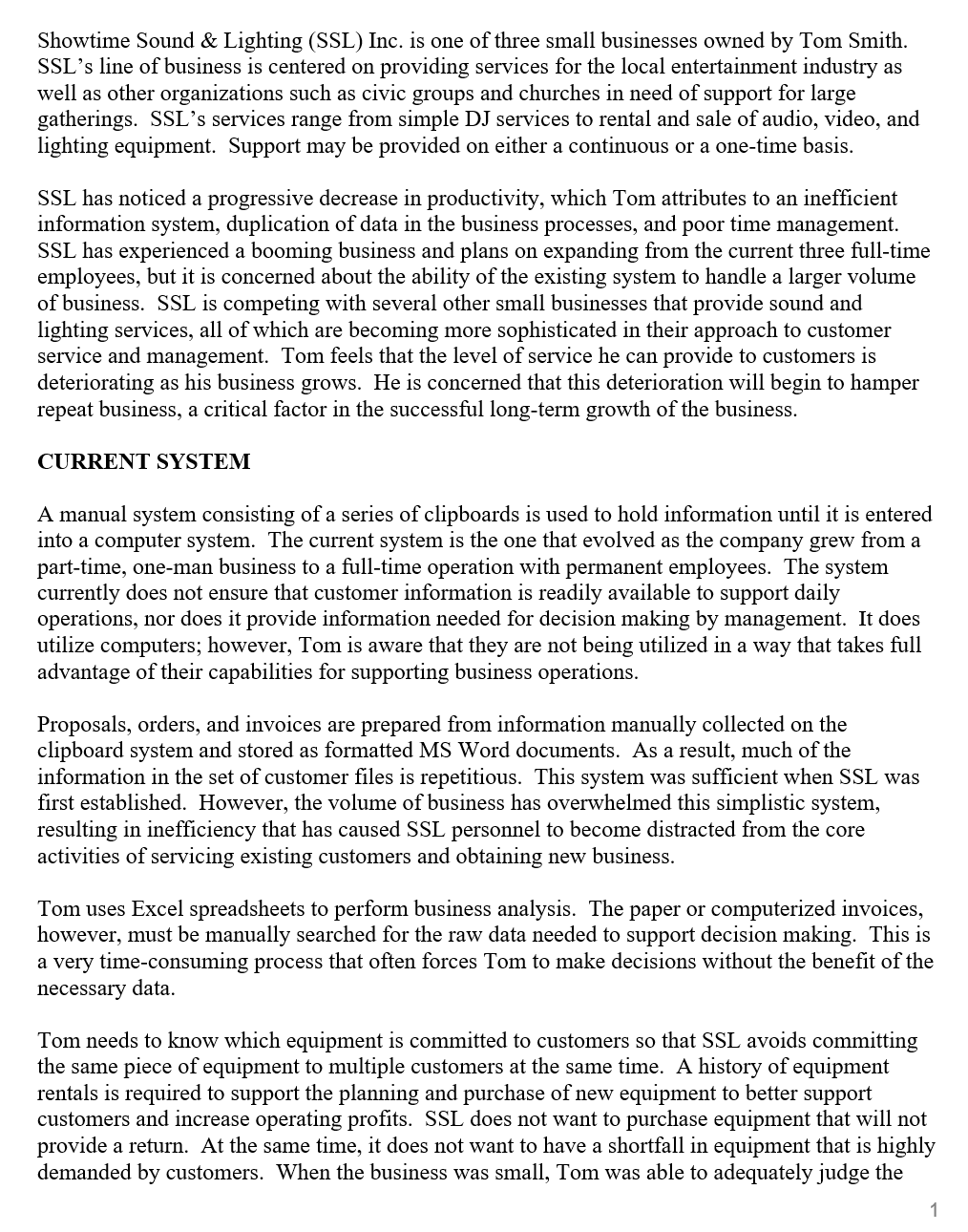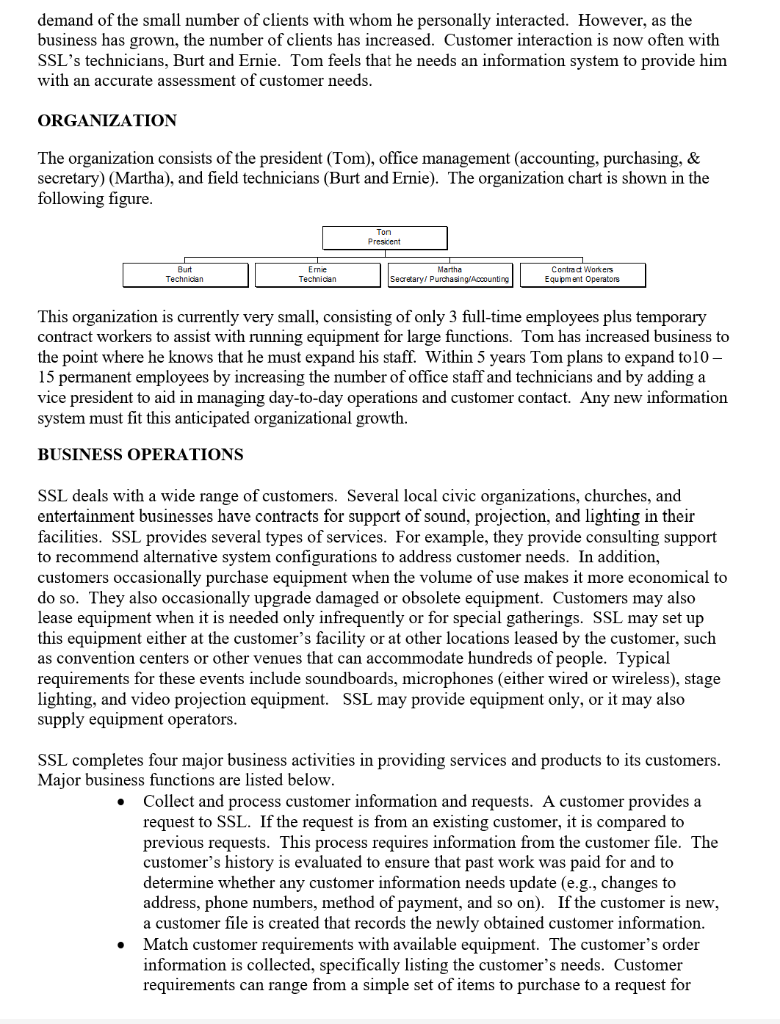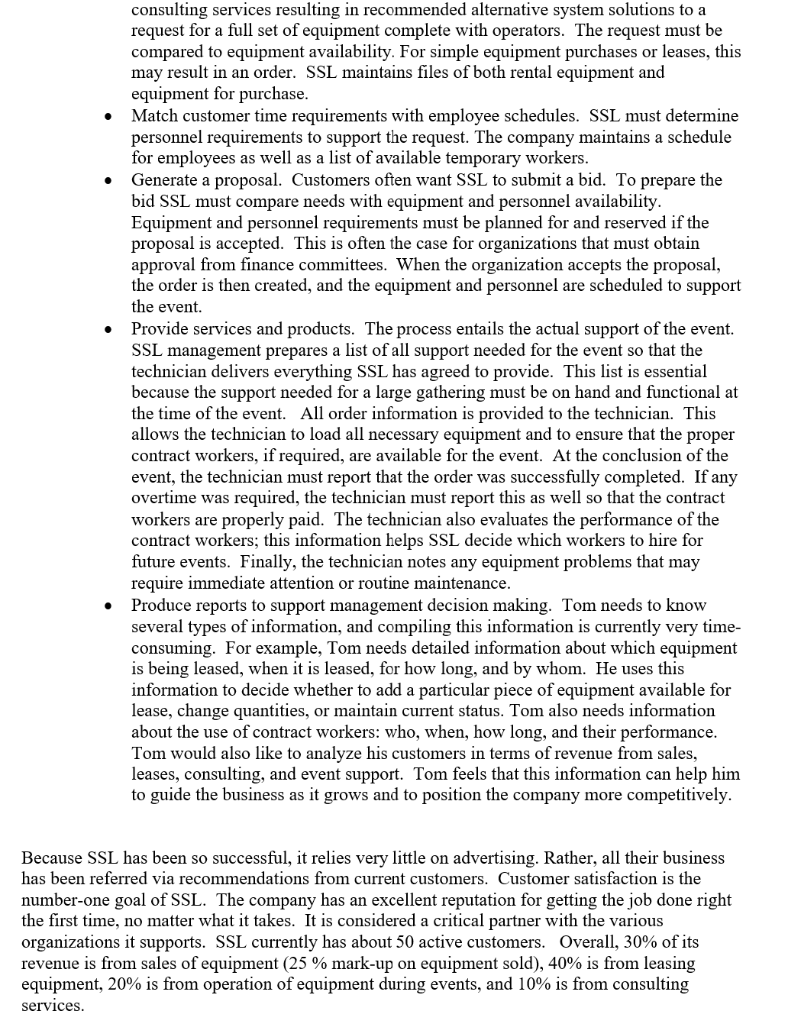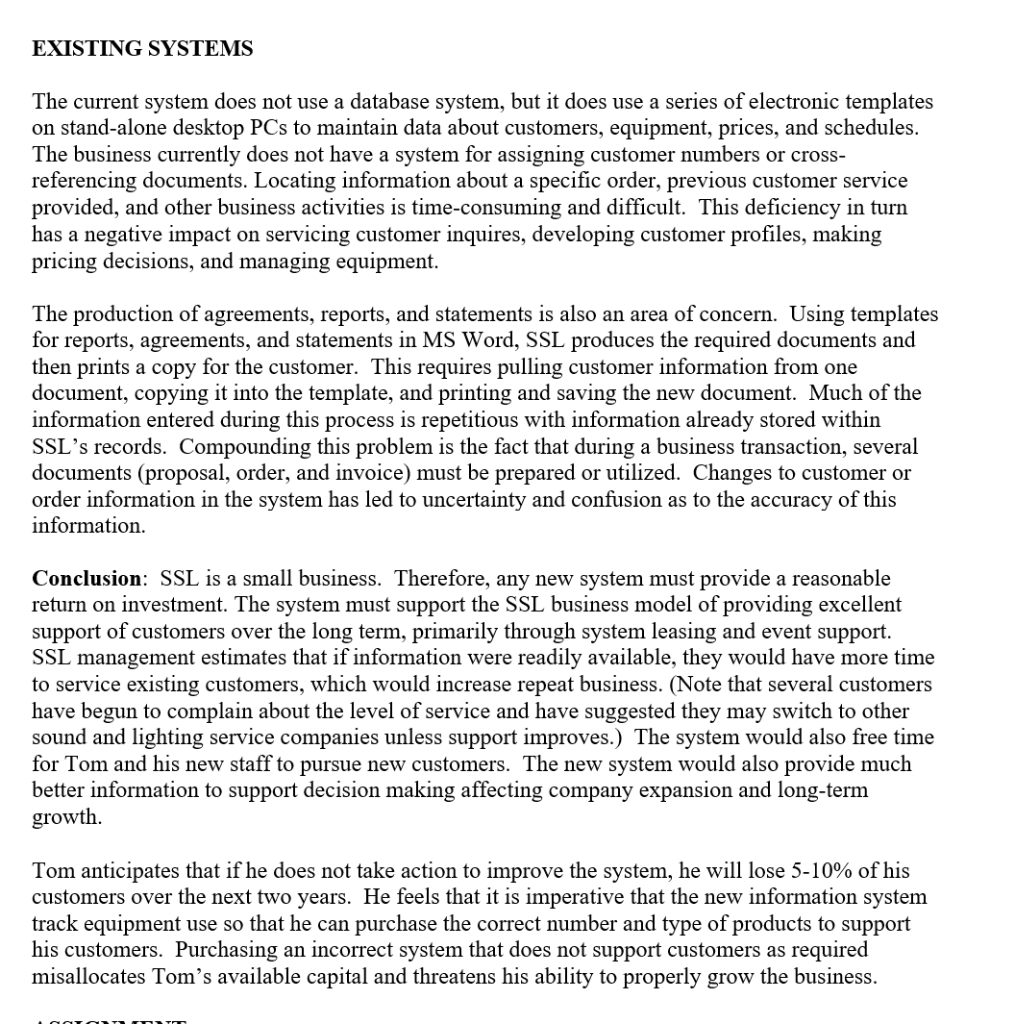Assignment-1: (Assume that the new system will be a networked desktop system.)
1.. Develop a list of requirements for the SSL Case Study for a new Information System based on the statements provided by the owner in the case.
2. For each requirement in (1) write a Use Case Document using the Use Case Form provided





Showtime Sound \& Lighting (SSL) Inc. is one of three small businesses owned by Tom Smith. SSL's line of business is centered on providing services for the local entertainment industry as well as other organizations such as civic groups and churches in need of support for large gatherings. SSL's services range from simple DJ services to rental and sale of audio, video, and lighting equipment. Support may be provided on either a continuous or a one-time basis. SSL has noticed a progressive decrease in productivity, which Tom attributes to an inefficient information system, duplication of data in the business processes, and poor time management. SSL has experienced a booming business and plans on expanding from the current three full-time employees, but it is concerned about the ability of the existing system to handle a larger volume of business. SSL is competing with several other small businesses that provide sound and lighting services, all of which are becoming more sophisticated in their approach to customer service and management. Tom feels that the level of service he can provide to customers is deteriorating as his business grows. He is concerned that this deterioration will begin to hamper repeat business, a critical factor in the successful long-term growth of the business. demand of the small number of clients with whom he personally interacted. However, as the business has grown, the number of clients has increased. Customer interaction is now often with SSL's technicians, Burt and Ernie. Tom feels that he needs an information system to provide him with an accurate assessment of customer needs. ORGANIZATION The organization consists of the president (Tom), office management (accounting, purchasing, \& secretary) (Martha), and field technicians (Burt and Ernie). The organization chart is shown in the following figure. This organization is currently very small, consisting of only 3 full-time employees plus temporary contract workers to assist with running equipment for large functions. Tom has increased business to the point where he knows that he must expand his staff. Within 5 years Tom plans to expand to 10 15 permanent employees by increasing the number of office staff and technicians and by adding a vice president to aid in managing day-to-day operations and customer contact. Any new information system must fit this anticipated organizational growth. BUSINESS OPERATIONS SSL deals with a wide range of customers. Several local civic organizations, churches, and entertainment businesses have contracts for support of sound, projection, and lighting in their facilities. SSL provides several types of services. For example, they provide consulting support to recommend alternative system configurations to address customer needs. In addition, customers occasionally purchase equipment when the volume of use makes it more economical to do so. They also occasionally upgrade damaged or obsolete equipment. Customers may also lease equipment when it is needed only infrequently or for special gatherings. SSL may set up this equipment either at the customer's facility or at other locations leased by the customer, such as convention centers or other venues that can accommodate hundreds of people. Typical requirements for these events include soundboards, microphones (either wired or wireless), stage lighting, and video projection equipment. SSL may provide equipment only, or it may also supply equipment operators. SSL completes four major business activities in providing services and products to its customers. Major business functions are listed below. - Collect and process customer information and requests. A customer provides a request to SSL. If the request is from an existing customer, it is compared to previous requests. This process requires information from the customer file. The customer's history is evaluated to ensure that past work was paid for and to determine whether any customer information needs update (e.g., changes to address, phone numbers, method of payment, and so on). If the customer is new, a customer file is created that records the newly obtained customer information. - Match customer requirements with available equipment. The customer's order information is collected, specifically listing the customer's needs. Customer requirements can range from a simple set of items to purchase to a request for consulting services resulting in recommended alternative system solutions to a request for a full set of equipment complete with operators. The request must be compared to equipment availability. For simple equipment purchases or leases, this may result in an order. SSL maintains files of both rental equipment and equipment for purchase. - Match customer time requirements with employee schedules. SSL must determine personnel requirements to support the request. The company maintains a schedule for employees as well as a list of available temporary workers. - Generate a proposal. Customers often want SSL to submit a bid. To prepare the bid SSL must compare needs with equipment and personnel availability. Equipment and personnel requirements must be planned for and reserved if the proposal is accepted. This is often the case for organizations that must obtain approval from finance committees. When the organization accepts the proposal, the order is then created, and the equipment and personnel are scheduled to support the event. - Provide services and products. The process entails the actual support of the event. SSL management prepares a list of all support needed for the event so that the technician delivers everything SSL has agreed to provide. This list is essential because the support needed for a large gathering must be on hand and functional at the time of the event. All order information is provided to the technician. This allows the technician to load all necessary equipment and to ensure that the proper contract workers, if required, are available for the event. At the conclusion of the event, the technician must report that the order was successfully completed. If any overtime was required, the technician must report this as well so that the contract workers are properly paid. The technician also evaluates the performance of the contract workers; this information helps SSL decide which workers to hire for future events. Finally, the technician notes any equipment problems that may require immediate attention or routine maintenance. - Produce reports to support management decision making. Tom needs to know several types of information, and compiling this information is currently very timeconsuming. For example, Tom needs detailed information about which equipment is being leased, when it is leased, for how long, and by whom. He uses this information to decide whether to add a particular piece of equipment available for lease, change quantities, or maintain current status. Tom also needs information about the use of contract workers: who, when, how long, and their performance. Tom would also like to analyze his customers in terms of revenue from sales, leases, consulting, and event support. Tom feels that this information can help him to guide the business as it grows and to position the company more competitively. Because SSL has been so successful, it relies very little on advertising. Rather, all their business has been referred via recommendations from current customers. Customer satisfaction is the number-one goal of SSL. The company has an excellent reputation for getting the job done right the first time, no matter what it takes. It is considered a critical partner with the various organizations it supports. SSL currently has about 50 active customers. Overall, 30% of its revenue is from sales of equipment ( 25% mark-up on equipment sold), 40% is from leasing equipment, 20% is from operation of equipment during events, and 10% is from consulting services. EXISTING SYSTEMS The current system does not use a database system, but it does use a series of electronic templates on stand-alone desktop PCs to maintain data about customers, equipment, prices, and schedules. The business currently does not have a system for assigning customer numbers or crossreferencing documents. Locating information about a specific order, previous customer service provided, and other business activities is time-consuming and difficult. This deficiency in turn has a negative impact on servicing customer inquires, developing customer profiles, making pricing decisions, and managing equipment. The production of agreements, reports, and statements is also an area of concern. Using templates for reports, agreements, and statements in MS Word, SSL produces the required documents and then prints a copy for the customer. This requires pulling customer information from one document, copying it into the template, and printing and saving the new document. Much of the information entered during this process is repetitious with information already stored within SSL's records. Compounding this problem is the fact that during a business transaction, several documents (proposal, order, and invoice) must be prepared or utilized. Changes to customer or order information in the system has led to uncertainty and confusion as to the accuracy of this information. Conclusion: SSL is a small business. Therefore, any new system must provide a reasonable return on investment. The system must support the SSL business model of providing excellent support of customers over the long term, primarily through system leasing and event support. SSL management estimates that if information were readily available, they would have more time to service existing customers, which would increase repeat business. (Note that several customers have begun to complain about the level of service and have suggested they may switch to other sound and lighting service companies unless support improves.) The system would also free time for Tom and his new staff to pursue new customers. The new system would also provide much better information to support decision making affecting company expansion and long-term growth. Tom anticipates that if he does not take action to improve the system, he will lose 5-10\% of his customers over the next two years. He feels that it is imperative that the new information system track equipment use so that he can purchase the correct number and type of products to support his customers. Purchasing an incorrect system that does not support customers as required misallocates Tom's available capital and threatens his ability to properly grow the business











